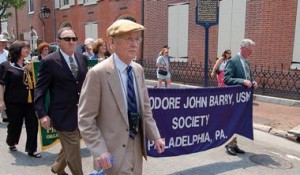The doctor was concerned. The cop who pulled him over on 4th Street and told him he’d have to wait till the parade went by was reassuring. “Don’t worry,” he said. “It won’t take long.”
In fact, the parade, led by a handful of pipers from the Philadelphia Emerald Society, lasted less than 10 minutes, winding its way from Old St. Mary’s Church to the south side of Independence Hall where the statue of Commodore John Barry, father of the US Navy, stands perpetually pointing to some distant place.
But it was long enough to attract the attention of Memorial Day patriots exploring the cradle of American democracy, many of whom lingered around the statue to listen to speaker after speaker teach a history lesson about a man of heroic proportion in life who is spectacularly little known in death.
The son of an Irish farmer, John Barry captured the first ship during the American Revolution and fought its final sea battle. He couldn’t be bought: Although he went unpaid (by about $6,000) by the Continental Congress for his service, he turned down a financial offer from British Lord Howe to change sides. “Not the value or command of the whole British fleet,” Barry replied, “can lure me from the cause of my country which is liberty and freedom.”
As commander of naval operations for the new nation, he supervised the building of the American fleet.
But he wasn’t above using some cunning when ships weren’t available: On January 5, 1778, while the Delaware was occupied by the British fleet, Barry organized the famous Battle of the Kegs, in which small kegs loaded with explosives were sent floating down the river at the British ships and fired upon, exploding them and throwing the British into a panic.
That same cunning came into play on land too. In 1787, when a minority of federal convention members opposed to the new constitution decided to go into hiding to prevent the formation of a quorum, Barry organized a group called The Compellers and physically forced enough of the seceding members back to form a quorum. The vote was taken, and the constitution was finally approved.
In his private life, he and his second wife, Sarah, had no children, but happily adopted Barry’s two nephews after his sister died. He was active in the Friendly Sons of St. Patrick, the Hibernian Fire Company, and the Ancient Order of Hibernians. “He was a faith-filled person,” Father Ed Brady told the congregation at Old St. Mary’s Church on 4th Street. Barry and his family are buried in the churchyard, along with half a dozen other famous Revolutionary era heroes, including Col. George Meade.
The day–which commemorated the erection of the Barry statue by the Friendly Sons of St. Patrick 100 years ago–started with a Mass and a ceremony honoring not only Barry, but his contemporary, Matthew Carey, who, like Barry, was Irish-born (a Dubliner) and a Philadelphia transplant. Carey used money loaned to him by the Marquis de Lafayette to start a newspaper in the city and later published the first Catholic Bible in the new world.
Though Carey was buried at Old St. Mary’s, his body and gravestone were relocated by his family to Holy Sepulchre Cemetery in Cheltenham. Concerned about setting history aright, a local amateur Barry historian, John Barry Kelly, contacted John Houlihan of the Barry Club of Brooklyn to help bring back Carey’s memory to his not-so-final resting place. Houlihan, a native of Dublin like Carey, decided to contact the board of the Dublin Society of New York to “get the ball rolling” to erect another memorial, which was unveiled on Sunday. Irish Deputy Consul General Brendan O’Caollai, also a Dubliner, took part in the ceremony. A portrait of Carey will hang in the church, where the Founding Fathers met to pray on July 4, 1779, the third anniversary of the signing of the Declaration of Independence.
And on this Memorial Day weekend, with history hanging heavy in the humid air, it repeated itself. Ten-year-old Morgan Hepburn of Phoenixville, whose great-great aunt Elise Hazel Hepburn helped dedicate the Barry statue in 1907 on the south side of Independence Hall, laid a wreath at the memorial of their common ancestor.

